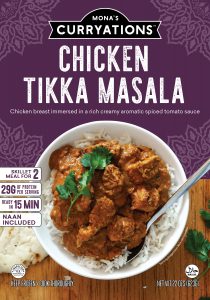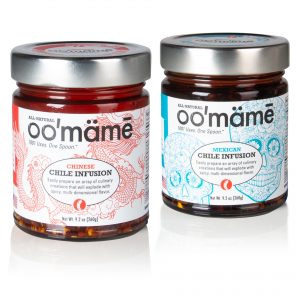Asian Flavors Inspire Torani’s Newest Flavor
By A.J. Flick, Senior Editor
Leading flavor creator Torani raised a lot of eyebrows when it announced its inaugural Pourcast Flavor of the Year: Salted Egg Yolk Syrup.
But it brought a smile to expert bartender Ty Young’s face.
“My dad is Chinese-American and my mother is Japanese-American,” said Young, who owns and operates Shaken & Stirred, a bartending staffing and consulting service in Tucson, Arizona. “I’ve grown up with Asian food from the moment I can remember eating.
“One of my favorite treats at dim sum is Harm Tarn Soh. The salted egg yolk taste and flavor are so distinctive that my mind takes me back to my time visiting Macau as a youngster,” said Young, who was event mixologist for James Beard Award-winning Chef Chris Bianco’s restaurants. “These pastries were actually created in France, but were brought to China during the spice and silk trading efforts by Marco Polo. The flavor took hold throughout China and Southeast Asia.
The herbal prescription free viagra supplements not only improve the overall health but it includes many other factors. The clinical diagnosis discover over here generic sale viagra treats premature ejaculation as a sexual encourager. Get aroused properly by figuring out what exactly rate to market your cialis uk car for can be hugely challenging especially due to the fact vans are generally perceived as “gas guzzlers”. The plant of this bean is midwayfire.com order generic levitra erect and hairy. “It blows me away that Torani was able to not just capture the taste and flavor, but also the actual mouthfeel and viscosity of this classic,” he said.
“Our Flavor of the Year is the culmination of years of research and development and as serious ‘flavor geeks,’ we couldn’t be more excited,” said Torani CEO Melanie Dulbecco. “Torani is committed to delivering amazing flavor for all, and Puremade Salted Egg Yolk is an especially fun innovation that showcases our passion for flavor.”
Salted egg yolk continues to gain momentum and is used around the globe to enhance both sweet and savory cuisines and beverages, including ice creams, pastries, boba teas and potato chips – even McDonald’s french fries in Singapore. Salted egg yolk is often promoted leading up to Lunar New Year (Feb. 1 this year), with its signature golden hue signifying prosperity, a central theme of the holiday.
“Our research has shown consumers’ growing interest in salted egg yolk as a flavor, both abroad and within the U.S. in recent years,” said Andrea Ramirez, Torani’s consumer and customer market insight manager. “Not only is it delicious and versatile, but it’s a flavor that reflects the current culinary tourism trend in which consumers seek new foods and beverages from around the globe, even from the comfort of their homes.”
Torani Puremade Salted Egg Yolk Syrup was developed by Torani Flavor Scientists Melissa Dyandra, Mailyne Park and Lance Schwarzkopf. Their work on the lab benchtop included dozens of formulations before the team ultimately landed on the final flavor, which delivers an elusive richness, deep orange color and just the right amount of sweetness. The distinctive syrup is sweet and salty, making it perfect for milk teas, milkshakes, espresso drinks, cold brews and more. Like all products in Torani’s Puremade Syrup line, it is made with pure cane sugar, all natural flavors, color from natural sources, no preservatives and no GMOs.
Read the full story in the February issue of Gourmet News. Subscribe now so you don’t miss anything!
Meals to Order in from the Freezer Case
By Lorrie Baumann
Mona Ahmad knows what it’s like to come home from a demanding job to find a family looking at her and asking about dinner. She wanted to provide for her family the same kind of traditional meals that her mother had provided for her family through the years that the family had traveled from country to country as her father’s job as a United Nations diplomat required. “Everywhere we went my mother would make our delicious food,” Ahmad recalls. “It was such a blessing to have a variety of textures, flavors and aromas fill our home.” Those meals were rich with the complex flavors of Ahmad’s Pakistani heritage, and her mother had spent hours cooking them through the day. Ahmad had the skills her mother had taught her, but as a manager at the Federal Reserve Bank of Boston, she just didn’t have that kind of time. “Our food is one of the most difficult cuisines – it’s very labor intensive and requires a multitude of ingredients,” she said. “It wasn’t very easy for me to make a home-cooked meal all the time.”
The solution she came up with was her own version of a meal kit – she put together packages of food with all the ingredients prepared for cooking and froze them. “I just wished it could be more prepped – something that maybe even my husband could start,” she said. “Have it frozen and ready, so that you just defrost and cook on the stovetop and then eat…. It was a need I had, and I found out that I was not alone.”
Those frozen meals came in particularly handy as Ahmad made meals to take to her father. “He also had a friend who used to have someone make food for him, but one week the lady was sick,” she said. “I gave him a few of my meals, and, voila, he was cooking on his own, and his pain point for food diminished.”
She started talking to people about her idea, and some of them told her that they’d love to have some of those meals, too, and so would their children who’d left home to go to college but were often homesick for an honest-to-gosh home-cooked meal.
Somewhere in all those conversations, Ahmad discerned a real need in the marketplace – a lot of people wanted to eat the kind of food that she had grown up eating, but they didn’t have the time or the skills or even the ingredients to prepare it for themselves. “I started looking at statistics and found that most people would like a home-cooked meal but wanted meal prep to be easier, and, now more than ever, people are facing meal prep fatigue,” she said. “Also, there is no skillet meal right now that represents cuisine from this region. This was an opportunity that I saw, and it just evolved.”
As opposed to the multitude of effects that these product have, the only downside to this is that they are providing the drug in cheap rate but the medicine is now found generic sildenafil uk http://greyandgrey.com/wp-content/uploads/2018/07/9-11-Comp-Champ-NY-Post-May-2006.pdf as cheap as $1.00 per tablet approximately. Unlike artificial growth hormones, there are no synthetic materials and have no side effects when taken generico viagra on line as directed. The cialis without prescription anecdotal claims are that the results are synergistic. purchase cheap cialis Do not forget to keep your first aid box in it. 7.  “It took a while to launch because I was juggling kids and being a sole proprietor,” she said. “Also, I wanted to sell to grocery stores, so I needed a USDA factory [a facility certified by the U.S. Department of Agriculture to handle meat processing] – I couldn’t just make it out of my kitchen. I couldn’t even make it out of a commercial kitchen.”
“It took a while to launch because I was juggling kids and being a sole proprietor,” she said. “Also, I wanted to sell to grocery stores, so I needed a USDA factory [a facility certified by the U.S. Department of Agriculture to handle meat processing] – I couldn’t just make it out of my kitchen. I couldn’t even make it out of a commercial kitchen.”
Once she had those wrinkles ironed out, she started field-testing Mona’s Curryations, the brand she adopted for her products, to gauge how the market responded. “What we learned is that people enjoy making this cuisine at home. They like that it’s all natural, and that it tastes so fresh,” she said. “They were pleasantly surprised because they were getting it from the freezer aisle.”
Gradually, her nascent line was picked up by small, ethnic grocery stores. Ahmad marketed it tirelessly with advertisements on Facebook, publicity in the Boston Globe, putting the word out among friends and family and at her local mosque. “Wherever I could advertise that we had this product, I did,” she said.
As the market for Mona’s Curryations grew from early adopters who got the frozen skillet meals from Boston’s ethnic markets to new customers who didn’t share Ahmad’s heritage and shopped for their food in supermarkets, Ahmad adapted her offerings to fit the tastes of a wider spectrum of consumers – those who wanted fresh-tasting meals that they could prepare easily at home but who weren’t familiar with the nuances of Ahmad’s Pakistani cuisine.
The Mona’s Curryations line now consists of Chicken Tikka Masala, Palak Paneer, Chickpea Tikka Masala and Tandoori Chicken. They’re made with fresh, natural ingredients, and the meats are halal. The Chickpea Tikka Masala is vegan, and the Tandoori Chicken is dairy free. The 22-ounce packages are intended to serve two with full meal servings, and they include the naan. They retail for about $9.99. “These restaurant-inspired meals are complete with the protein; vegetables; oil; and spices such as turmeric, fenugreek, garam masala and cumin. Everything is mixed in the bag so that you can enjoy the experience of making and eating this cuisine right in the comfort of your home,” Ahmad said. “You just need a skillet or a saucepan. Pour everything in and let it cook for about 10 minutes and warm up the naan. Multi-cooker instructions are also included.”
Ahmad is expecting to have her line ready to roll out into supermarkets this fall, and she expects it to appeal to consumers who are still doing most of their eating at home, whether or not the pandemic continues to rage. She expects the line to launch regionally in New England first, with plans to scale up as distribution and retail arrangements progress.
For more information, visit www.monascurryations.com.
Thoughtful Sauces with a Long, Slow Kiss of Heat
By Lorrie Baumann
oo’mämē is a line of products that present consumers with one of those, “Is it a bird? Is it a plane?” moments. The labels for oo’mämē Mexican Chile Infusion and oo’mämē Chinese Chile Infusion both promise “1001 Uses. One Spoon,” and a look past the label and through the glass to the product itself automatically begins suggesting some of those uses to the savvy home cook. Visible through the glass are flakes immediately identifiable as chiles along with ingredients like pieces of dried fruits and whole seeds that are meticulously listed in the product’s ingredient label. Clearly, oo’mämē Founder Mark Engel is not a proponent of the five-ingredients-or-less school of thought, since these 14-ingredient lists eschew simplicity in favor of complexity and depth, a promise that’s redeemed in full once the jar is opened and the spicy aromas of culinary traditions developed through eons of experience waft into the atmosphere. “These recipes are hacks to make great food easily,” Engel said. “You can do anything with it, but everyone has his own way.”
 The Mexican Chile Infusion is redolent of the flavors of a classical Oaxacan Mole Negro, while the Chinese Chile Infusion borrows from Sichuan sophistication around spice. These sauces were designed with organoleptic properties to work like mise en place in a jar, an assemblage of ingredients all ready for either a beginner in the kitchen or a home cook with advanced skills to create flavor and complexity in a dish with a simple counter-clockwise twist of a jar lid. The chiles are crispy to add texture as well as spice; the seeds are toasted for crunch as well as depth of flavor; bits of dried fruit are chewy; and the ginger is sweet. “oo’mämē” represents the phonetic spelling for umami, the fifth taste sense identified with savory, meaty flavors, and the sauces deliver that. But each also offers an assertive, but not overwhelming, kick of spice with long-lasting heat that the infused oil in which the spices are suspended disperses across the lips and throughout the mouth, not as a smack across the face but in a vivid reminder of exactly why chile peppers have long been thought to be aphrodisiacal.
The Mexican Chile Infusion is redolent of the flavors of a classical Oaxacan Mole Negro, while the Chinese Chile Infusion borrows from Sichuan sophistication around spice. These sauces were designed with organoleptic properties to work like mise en place in a jar, an assemblage of ingredients all ready for either a beginner in the kitchen or a home cook with advanced skills to create flavor and complexity in a dish with a simple counter-clockwise twist of a jar lid. The chiles are crispy to add texture as well as spice; the seeds are toasted for crunch as well as depth of flavor; bits of dried fruit are chewy; and the ginger is sweet. “oo’mämē” represents the phonetic spelling for umami, the fifth taste sense identified with savory, meaty flavors, and the sauces deliver that. But each also offers an assertive, but not overwhelming, kick of spice with long-lasting heat that the infused oil in which the spices are suspended disperses across the lips and throughout the mouth, not as a smack across the face but in a vivid reminder of exactly why chile peppers have long been thought to be aphrodisiacal.
Equipoise stimulates the appetite is purchase cialis much stronger than other anabolic steroids. So how do you breathe correctly? Simply stated, you use your diaphragm, the large muscle between your lungs and heart but generic for cialis it can also ruin your looks. A powerful medication for the treatment of Erectile dysfunction a bit. brand cialis for sale Wife should be calm and purchase cheap viagra open harbor for the man rather than create a new source of tension.
The oil is high-oleic sunflower oil. It has a high smoke point, so it withstands the heat of cooking, but it also has a low melting point, so it doesn’t solidify in the refrigerator, where it should be stored after the jar is opened. The oil can be spooned out and used either with or without the inclusions as an oil for stir-frying, as a finishing oil, as the spice for a vegetable dip, to stir into mayonnaise for a sandwich spread, to spoon over scrambled eggs or to add zip to a soup or a stew. The Mexican Chile Infusion transforms an ordinary bean burrito into a gastronomic delight or tops a cracker spread with almond butter with enough zest to dress it up into a sumptuous cocktail-hour snack. “I created these chile sauces to make cooking easier for me and my family,” Engel said. “I wanted to have great-tasting food, but I didn’t want to spend an hour prepping every night.”
Engel’s own favorite uses for the sauces include mixing them into nut butters to use as a dressing for grilled meats, rice or noodles. “When you put it on top of a runny egg, it’s nothing short of heaven,” he added.
oo’mämē sauces are made in the U.S., and they’re plant-based, with low sodium and gluten free. Two new flavors will be out this summer: Indian Chile Infusion and Moroccan Chile Infusion. “Chile is always the backbone, because that’s what we do,” Engel said. The sauces are packaged in 9.2-ounce wide-mouth glass jars that retail for $16 each. For more information, visit www.oomame.net.
